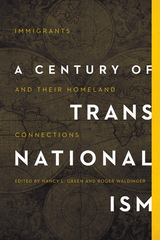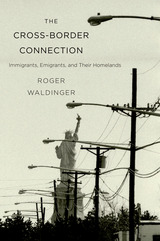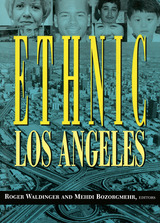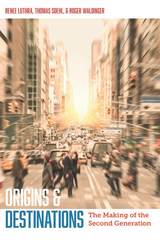

International migration presents the human face of globalization, with consequences that make headlines throughout the world. The Cross-Border Connection addresses a paradox at the core of this phenomenon: emigrants departing one society become immigrants in another, tying those two societies together in a variety of ways. In nontechnical language, Roger Waldinger explains how interconnections between place of origin and destination are built and maintained and why they eventually fall apart.
“When are immigrants ‘us’? When are they ‘them’? Waldinger implores readers to reframe the debate from a before-after dichotomy to a new transnational approach, revealing migrants to be here, there, and in-between at all stages of their migration tenure…The book’s real strength is in the elegance of the author’s argument, supported by evidence that transnationalism itself is not static but an ongoing dialectic.”
—R. A. Harper, Choice
“The Cross-Border Connection is to be commended for putting substance into the black box of transnationalism, offering scholars a dynamic model to account for the ebb and flow of transnationalism in the real world and yielding testable propositions about the circumstances under which cross-border connections can be expected to expand or contract.”
—Douglas S. Massey, American Journal of Sociology


Using surveys of second generation immigrant adults in New York and Los Angeles, Origins and Destinations explains why second generation experiences differ across national origin groups and why immigrant offspring with the same national background often follow different trajectories. Inter-group disparities stem from contexts of both emigration and immigration. Origin countries differ in value orientations: immigrant parents transmit lessons learned in varying contexts of emigration to children raised in the U.S. A system of migration control sifts immigrants by legal status, generating a context of immigration that favors some groups over others. Both contexts matter: schooling is higher among immigrant children from more secular societies (South Korea) than among those from more religious countries (the Philippines). When immigrant groups enter the U.S. migration system through a welcoming door, as opposed to one that makes authorized status difficult to achieve, education propels immigrant children to better jobs.
Diversity is also evident among immigrant offspring whose parents stem from the same place. Immigrant children grow up with homeland connections, which can both hurt and harm: immigrant offspring get less schooling when a parent lives abroad, but more schooling if parents in the U.S. send money to relatives living abroad. Though all immigrants enter the U.S. as non-citizens, some instantly enjoy legal status, while others spend years in the shadows. Children born abroad, but raised in the U.S. are all everyday Americans, but only some have become de jure Americans, a difference yielding across-the-board positive effects, even among those who started out in the same country.
Disentangling the sources of diversity among today’s population of immigrant offspring, Origins and Destinations provides a compelling new framework for understanding the second generation that is transforming America.

Still the Promised City? addresses the question of why African-Americans have fared so poorly in securing unskilled jobs in the postwar era and why new immigrants have done so well. Does the increase in immigration bear some responsibility for the failure of more blacks to rise, for their disappearance from many occupations, and for their failure to establish a presence in business?
The two most popular explanations for the condition of blacks invoke the decline of manufacturing in New York and other major American cities: one claims that this decline has closed off job opportunities for blacks that were available for earlier immigrants who lacked skills and education; the other emphasizes "globalization"--the movement of manufacturing jobs offshore to areas with lower labor costs. But Roger Waldinger shows that these explanations do not fit the facts. Instead, he points out that a previously overlooked factor--population change--and the rapid exodus of white New Yorkers created vacancies for minority workers up and down the job ladder. Ethnic succession generated openings both in declining industries, where the outward seepage of whites outpaced the rate of job erosion, and in growth industries, where whites poured out of bottom-level positions even as demand for low-level workers increased. But this process yielded few dividends for blacks, who saw their share of the many low-skilled jobs steadily decline. Instead, advantage went to the immigrants, who exploited these opportunities by expanding their economic base.
Waldinger explains these disturbing facts by viewing employment as a queuing process, with the good jobs at the top of the job ladder and the poor ones at the bottom. As economic growth pulls the topmost ethnic group up the ladder, lower-ranking groups seize the chance to fill the niches left vacant. Immigrants, remembering conditions in the societies they just left, are eager to take up the lower-level jobs that natives will no longer do. By contrast, African-Americans, who came to the city a generation ago, have job aspirations similar to those of whites. But the niches they have carved out, primarily in the public sector, require skills that the least educated members of their community do not have. Black networks no longer provide connections to the lower-level jobs, and relative to the newcomers, employers find unskilled blacks to be much less satisfactory recruits. The result is that a certain number of well-educated blacks have good middle-class jobs, but many of the less educated have fallen back into an underclass. Grim as this analysis is, it points to a deeper understanding of America's most serious social problem and offers fresh approaches to attacking it.
READERS
Browse our collection.
PUBLISHERS
See BiblioVault's publisher services.
STUDENT SERVICES
Files for college accessibility offices.
UChicago Accessibility Resources
home | accessibility | search | about | contact us
BiblioVault ® 2001 - 2024
The University of Chicago Press









